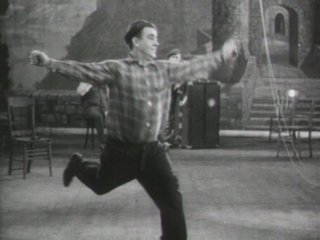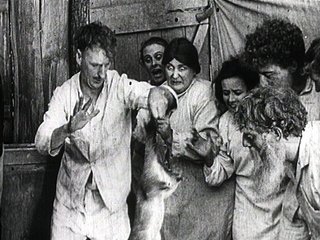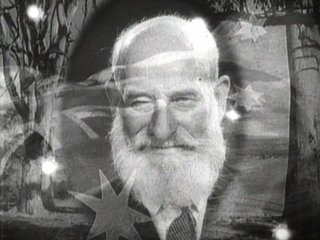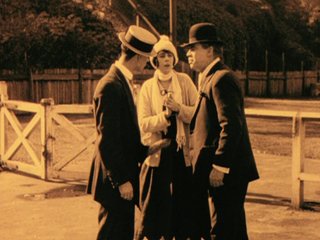Australian Comedy Part 1: The Silent Era
Is there such a thing as Australian comedy? Can we honestly say that we have developed our own vernacular styles, something homegrown, rather than imported from the US or Britain? And if there is such a thing, how do we define it?
George Wallace
Let’s start by taking a look at something we have lost – the sound of a certain kind of Australian language. George Wallace was the most important Australian comedian of the 1930s and ’40s, and the only vaudeville performer who successfully migrated to the new medium of sound films after 1927. Wallace spoke with an accent that could not be anything but Australian, and he used language that was identifiably and particularly Australian. In clip one of His Royal Highness (1932), we hear a broad Australian accent that has largely disappeared from our popular media. That may be the influence of many things, but one of them is the rise of American television programming in Australia after 1956. Television has changed the modern Australian accent a great deal.
This routine comes straight from the vaudeville stage. George Wallace’s first three films in the 1930s were all based on his stage routines. They were directed by Frank W Thring, and were rudimentary in terms of style: George stood in front of the camera and did his stuff, like he had done on stage. Even so, they were popular with audiences. Before the talking picture, you had to get to a vaudeville theatre, probably in the city, to see Wallace’s particular form of comedy.
Born into a family of comedians, he had perfected a childlike persona, playing a simple farm boy of limited intelligence who gets caught up in adventures in the wider world. In this film, he is working as a stagehand in a theatre when he gets a knock on the head. For the rest of the film, he thinks he is the king of a small European kingdom.
The film is based on one of the most enduring structures in filmed comedy – the fish out of water. The jokes are built around the idea of an Australian abroad. His language and mannerisms are gauche, but he has a kind of native humour. He finds his surroundings hilarious, especially the obsequious gestures of the servants. In a sly way, the comedy asserts something that many Australians in the 1930s held dear–a sense of equality and a disdain for the hierarchies of the old world. In this case, it is a comic European kingdom, but the real target was the British Crown and British manners.
Wallace uses phrases that have almost disappeared from our language: ‘stop acting the goat’, for instance. These were not quite ironic at the time. They were in common usage, at least among working-class Australians. Wallace’s films were made at the height of the Depression, between 1932 and 1939, and they appealed greatly to working-class audiences, desperate to be cheered up (see also The Depression).
Ken G Hall, who directed some of Wallace’s best comedies later in the ’30s, described him as ‘the people’s comedian’ and that was true. If there is an authentic Australian comedic character, then George Wallace was it, at that time. He was one of the funniest comedians we have produced, although he was not the first in this domain. The working-class bloke with a good heart who’s none too bright goes back a long way in our films, and he has never really disappeared. Paul Hogan played a version of him, but made him smarter. The family in The Castle (1997) are related, as are Kath and Kim (2002). He can be a she. In these early versions, he was usually a bloke and he had both rural and urban variations.
Dad Rudd
Which one came first is difficult to say, but they were both well represented in silent Australian comedy before 1920. The stories of ‘Steele Rudd’ (the pen name of Arthur Hoey Davis) were popular before cinema existed, from about 1895. They are the source of one of the most enduring rural examples, Dad Rudd and his son Dave, along with the rest of the large Rudd family. These pioneer settlers battling drought, fire and poverty featured in their first movie in 1920.
On Our Selection (1920) was directed by Raymond Longford, the most gifted Australian filmmaker of the silent era, but the material was already familiar to audiences, through a popular stage play. The New Zealand-born actor Bert Bailey, with Edmund Duggan, adapted the stories in 1912, making the Rudds into bush caricatures.
Longford did not like the ridicule in Bailey’s version; he thought the play gave the impression ‘that our backblocks are populated with a race of unsophisticated idiots’. That is presumably why Bert Bailey did not get to play Dad Rudd in this first movie version, although he would play him in four later versions. Longford’s style of comedy was also broad in this film, but affectionate. There is a sense of human dignity, even as the family members fall about trying to escape the possum and the goanna.
That Longford would try to reform the way these characters were seen tells us that they were well entrenched as caricatures. That was probably even true when they were written in 1895. They depicted a 19th-century Australian bush family that was arguably out of date already. That is part of what made them funny. Audiences could see an aspect of themselves and think, ‘we’ve moved on from those humble origins’.
That was true. By the end of the 19th century, Australians were concentrating in the cities and there was growing nostalgia for the bush life. Comedic writers like ‘Banjo’ Paterson and Henry Lawson were both country-born, but they wrote much of their output in the cities, working for newspapers.
Like Steele Rudd, they were writing about times that had passed, for readers who were receptive to stories that honoured the pioneering, nationalistic spirit. And there was plenty of nationalism going round: the Australian Labor Party was formed under a Queensland tree in 1891, and Federation came in 1901.
Dad Rudd and his family, as comical as they may be, never lost that sense of the heroic. That nationalism is one of the threads that runs through the whole history of Australian comedy, like a seam of gold. Comedy helps to define a national identity, our sense of self, but it is never just one thing. Dad Rudd was immensely popular, but he never had the field of play to himself.
The Bloke
Australia went to war in 1914. In 1915, CJ Dennis published The Songs of the Sentimental Bloke, the story of Bill the Bloke, a larrikin from Little Lonsdale Street, Melbourne. In fact, Bill was a petty criminal, member of a ‘push’, or youth gang.
That word larrikin had been first used in the late 19th century in Sydney to describe the Rocks Push, who were notorious for ‘rolling’ drunken sailors in one of the toughest areas of the city, the docks around Millers Point. There were other pushes in Woolloomooloo, Surry Hills, Glebe, and Darling Harbour. The members of these gangs were capable of serious violence, although usually not murder.
There was a certain admiration in the term larrikin: they were naughty boys, irreverent to authority, and that had always been popular in a country that was founded as a penal colony. CJ Dennis’s book was an immediate bestseller. It may have been that Bill the larrikin appealed to readers as a mirror of the spirit of the Australian soldiers then fighting in Europe, who had a growing reputation for ill-discipline, or it may have been that he offered an escape from the appalling casualty news from the front. It might have been neither.
Bill’s appeal was partly his language, just as it would be for George Wallace a few years later. He spoke in a colourful inner-city argot that was partly related to Cockney English. He dropped letters all over the place, and made up his own spelling. CJ Dennis exaggerated that language in a way that made Bill seem lovable, if also not too bright. He was a ‘boob’, in the same way that Dave Rudd, son of Dad, was a boob. Bill was the city version of the same tradition, the working-class bloke with a good heart – except that Bill didn’t much like work.
Adapting CJ Dennis to the screen was a perfect fit, because silent comedy needed titles and those were ready-made in Dennis’s text. It would be harder to make The Sentimental Bloke (1919) work in the sound era, precisely because the language was so extreme. None of the later attempts was as successful as the 1919 film, directed by Raymond Longford.
It is difficult today to respond in a way that audiences did then, partly because we know less than they did. Modern audiences do not recognise that Bill’s clothes identify him as a lout, a member of a push. They knew that the ‘stror ‘at coot’ was probably a member of the Straw Hat Push, from another part of town. Many of them also knew the text, because the book was so popular. The film was a huge hit. It established a stock character that has never quite left us – the urban boob. Here’s an example from an Australian film made almost 50 years later.
Frank (John Hargreaves) is a career criminal who has taken a room in a house owned by Malcolm (Colin Friels), a young man who is socially inept, but a mechanical genius. Frank is planning a robbery using Malcolm’s inventions. Malcolm was made in 1986, and directed by Nadia Tass. It is set in the inner suburbs of Melbourne, not far from the area that gave us Bill, the bloke from CJ Dennis.
There are many variations on this inner-city scallywag character. In The Kid Stakes, from 1927, directed by Tal Ordell, inner-city children from Woolloomooloo try to win a race with their pet goat Hector. The lead character, played by the son of the director, is called Fatty Finn, based on a cartoon strip character created by Syd Nicholls in 1923. Fatty Finn is virtually a miniature version of Bill the Bloke, a larrikin child with his own gang of half-pint accomplices – a mini-push. This film was even shot on the same streets that Longford used in 1919 for The Sentimental Bloke.
Were these authentic Australian comedies, or imitations of American silent comedies, the flow of which was virtually unstoppable from the end of the First World War? It was probably a little of both. The American cinema was certainly producing a popular series of movies about naughty children having adventures (the Our Gang series), but most of the antecedents of these characters came from the Australian popular media, principally newspapers. They were trading on popularity the characters had already achieved.
Go to Australian Comedy Part 2: The Early Sound Era »
Go to Australian Comedy Part 3: 1950s–1980s »
Titles in this collection

His Royal Highness 1932
The performance of George Wallace, star and writer, is a road map of comic techniques from the passing vaudeville era.

Kath and Kim – Money 2002
Kath’s 'look at moi’ is the show’s most famous catchphrase and the vernacular of the 'foxy ladies’ has become a recognisable fixture in popular culture.

The Kid Stakes 1927
The Kid Stakes is one of the greatest comedies of the silent era, although it was largely dismissed at the time as simply a children’s film.

Malcolm 1986
Malcolm is one of the most charming modern Australian comedies, and probably the closest we’ve come to matching the joyful silliness of Britain’s 1950s Ealing comedies.

On Our Selection 1920
On Our Selection is a landmark of the silent era in Australian cinema, and one of the key films in the career of Raymond Longford, the greatest director of that period.

The Sentimental Bloke 1919
Director Raymond Longford and leading lady Lottie Lyell wrote this together and it is probably their most successful collaboration.








